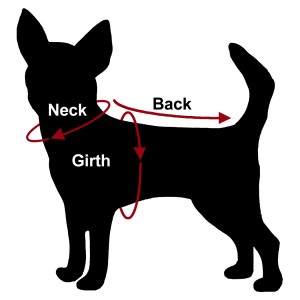 When making clothes for your dog, it is important to get accurate measurements to ensure the most comfortable fit for your pet. Use a cloth or plastic tape measure for the most accurate measurements and make sure your dog is standing as shown in the illustration-not sitting or lying down.
When making clothes for your dog, it is important to get accurate measurements to ensure the most comfortable fit for your pet. Use a cloth or plastic tape measure for the most accurate measurements and make sure your dog is standing as shown in the illustration-not sitting or lying down.
I design most of my crochet and sewing patterns to fit small dogs up to 16″ girth. (Some patterns have sizes up to 17″ girth.) Of course, body proportions vary depending on the breed, which is why I also design my patterns so they are easy to alter to custom fit your dog.
Three Important Measurements
The three key measurements to ensure a correct fitting garment for your dog are:
Neck – This measurement should be taken around the neck as you would for a collar.
Girth (Chest) – Measure the girth or chest at the widest point, all the way around your dog. This is typically right behind the front legs.
Back Length – Measure along your dog’s backbone from the base of the neck to the base of the tail. This would be where the collar sits to where the tail meets the rear.
I give finished garment measurements for all my patterns and for many patterns, I provide instructions/options for you to make alterations to back length, girth or collar if necessary.
When making garments for your dog, add at least 1″ for ease in the girth and 1″ in the neck. Again, this may vary depending on the type of yarn or fabric you are using. Some yarns and fabrics stretch much more than others. For a looser fit, allow as much as 2-3″ in girth. Garment back length is easy to adjust and depends on the garment style or look as to whether you want it to run the full back length or not.
When crocheting or knitting for your pet, it is also equally important to check your gauge and do a gauge swatch to check for accuracy. Going up or down in needle size may help you get a more accurate finished garment.


